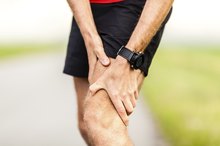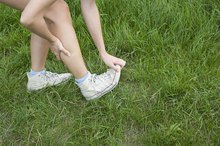Vitamin B-12 Deficiencies & Leg Spasms
You've no doubt experienced a muscle cramp before. It's extremely painful but usually doesn't last long. Sometimes you get them while you exercise or right after your workout. Or you might get them in the middle of the night. There are several causes of muscle spasms, including dehydration, electrolyte imbalances and overworked muscles or muscle injury. You can take several actions to prevent muscle spasms -- but they don't usually involve vitamin B-12.
Vitamin B-12 Deficiency
B-12 is a water-soluble vitamin that your body uses to make red blood cells. It is naturally attached to protein in food and is separated from the protein in your stomach. The vitamin can also be found in supplements in free form, which isn't bound to protein. Deficiency of vitamin B-12 doesn't cause leg spasms, but it can cause megaloblastic anemia, which leads to fatigue and weakness as well as constipation, loss of appetite and weight loss. Depression, confusion and numbness or tingling in the hands and feet are also symptoms of the deficiency. If you are found to be deficient in vitamin B-12, you will either be given high oral doses of the vitamin, or you'll receive vitamin B-12 injections.
- B-12 is a water-soluble vitamin that your body uses to make red blood cells.
- If you are found to be deficient in vitamin B-12, you will either be given high oral doses of the vitamin, or you'll receive vitamin B-12 injections.
Leg Spasms
Muscle Twitches and Supplements
Learn More
You experience muscle spasms when a muscle contracts without your control and without relaxing. When these spasms occur in the leg, it's often called a charley horse. While vitamin B-12 deficiency doesn't cause a muscle spasm, the spasm can be caused by dehydration, electrolyte depletion or overworking or injuring the muscle. Other spasms -- especially neck spasms -- can be a sign of stress.
- You experience muscle spasms when a muscle contracts without your control and without relaxing.
- While vitamin B-12 deficiency doesn't cause a muscle spasm, the spasm can be caused by dehydration, electrolyte depletion or overworking or injuring the muscle.
Fluid & Electrolytes
As one of the causes of these spasms, dehydration will often occur when you have been exercising, sweating or experiencing vomiting or diarrhea due to illness. Potassium is extremely important in preventing muscle spasms. When you are replenishing lost fluid, get plenty of electrolytes as well. You can do this by drinking a low-calorie sports drink or having a snack such as an orange or banana. If you have kidney problems, consult your health care provider. Increasing your fluid and potassium intake can be stressful to your kidneys. Toxicity from too much potassium is rare in healthy individuals because the extra potassium is easily excreted.
- As one of the causes of these spasms, dehydration will often occur when you have been exercising, sweating or experiencing vomiting or diarrhea due to illness.
- Increasing your fluid and potassium intake can be stressful to your kidneys.
Treatment Options
Does Potassium Aid in Weight Loss?
Learn More
You can treat muscle spasms with heat to relax the muscle, as well as gently massaging the muscle. Properly stretching before exercise can help prevent muscle spasms. When you exercise, make sure that you're exercising within your abilities since overusing or straining your muscles may cause spasms. Get plenty of potassium in your diet by eating fruits, vegetables, low-fat or nonfat dairy products, legumes and lean meats. Drink plenty of fluids to prevent dehydration.
- You can treat muscle spasms with heat to relax the muscle, as well as gently massaging the muscle.
- When you exercise, make sure that you're exercising within your abilities since overusing or straining your muscles may cause spasms.
Related Articles
References
- Office of Dietary Supplements: Vitamin B12
- University of Maryland Medical Center: Charley Horse
- MedlinePlus: Muscle Twitching
- Jahan F, Nanji K, Qidwai W, Qasim R. Fibromyalgia syndrome: an overview of pathophysiology, diagnosis and management. Oman Med J. 2012;27(3):192-5. doi:10.5001/omj.2012.44
- Sluka KA, Clauw DJ. Neurobiology of fibromyalgia and chronic widespread pain. Neuroscience. 2016;338:114-129. doi:10.1016/j.neuroscience.2016.06.006
- Doraisamy MA, Anshul . Effect of latent myofascial trigger points on strength measurements of the upper trapezius: a case-controlled trial. Physiother Can. 2011;63(4):405-9. doi:10.3138/ptc.2010-27
- Jafri MS. Mechanisms of myofascial pain. Int Sch Res Notices. 2014;2014. doi:10.1155/2014/523924
- Gür A, Karakoç M, Nas K, Cevik R, Saraç J, Demir E. Efficacy of low power laser therapy in fibromyalgia: a single-blind, placebo-controlled trial. Lasers Med Sci. 2002;17(1):57-61. doi:10.1007/s10103-002-8267-4
- Ruaro JA, et al. Lasers in medical science. 2014 Nov;29(6):1815-9. Low-level laser therapy to treat fibromyalgia.
- Vayvay ES, et al. Journal of back and musculoskeletal rehabilitation. 2016 Jan 25;29(1):77-83. The effect of Laser and taping on pain, functional status and quality of life in patients with fibromyalgia syndrome: A placebo- randomized controlled clinical trial.
- Ge HY, et al. Arthritis research & therapy. 2011 Mar 22;13(2):R48. Reproduction of overall spontaneous pain pattern by manual stimulation of active myofascial trigger points in fibromyalgia patients.
Writer Bio
Lisa Coffman is a food and nutrition specialist based in Iowa. She has spent time working with the elderly in long term care, nutrition education for low income families and food intolerances and food allergies. She is currently finishing her Bachelor of Science in human food and nutrition from the University of Wyoming.









